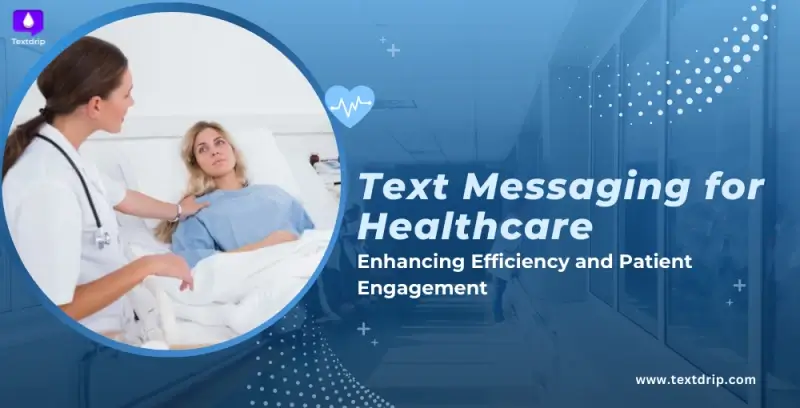
16 Jul 2024

Dhaval Gajjar


16 Jul 2024

Dhaval Gajjar
Text messaging for healthcare? Why is it required? Is it worth the investment for healthcare organizations? How can healthcare organizations use SMS to its full potential? This blog will solve all your doubts. Keep reading!
Active listening and open communication are vital in the healthcare industry. How healthcare streamlines and facilitates communication with patients and caregivers shows the quality of their service and treatment. Without proper communication, patients and healthcare professionals have to face various challenges, such as:
Missed Appointments – Patients forget about their scheduled appointments and don’t show up on time. It will lead to a waste of resources and decreased revenue.
Medication Non-Adherence – When there is no proper communication, there might be a high chance that patients do not follow the prescribed medication regimens. It can create various health issues.
Communication Gaps – Healthcare providers face challenges reaching patients for follow-ups, reminders, and information sharing.
Complex Scheduling – Managing appointments, follow-ups, and consultations is challenging for healthcare providers and patients.
Here is where effective text messaging for healthcare comes into the picture.
Text messaging is a simple, direct, and effective way to deal with such issues. SMS helps streamline communication, send timely reminders, and ease better patient engagement.
As per the study, 98% of patients prefer to receive SMS over calls, and 95% of patients feel more connected when they receive text messages from their healthcare provider team.
In this blog post, we will discuss how healthcare organizations can benefit from using text messaging in healthcare and how they can enhance efficiency and patient engagement using text messaging for healthcare.
On that note, let’s dive into it.
Secure text messaging for healthcare not only improves communication but also enhances overall patient management. Check out these key benefits of implementing text messaging in healthcare.
Text messaging is an easy, convenient, and familiar approach. Even if the person is not tech-savvy, they can easily use it. Besides, when you use a specialized SMS marketing platform for healthcare, patients do not need to download any additional software or learn the new interface. So healthcare providers can seamlessly reach a wider audience.
Text messaging is a two-way communication approach. So, it lets patients and healthcare providers connect. Patients can ask their queries, give feedback, or request information. Increased patient engagement can lead to better results, efficient healthcare delivery, and improved satisfaction.
Text messaging for healthcare providers can assist them in reducing administrative overhead and improving resource allocation. As compared to phone calls, SMS costs are relatively low. Besides using SMS automation tools, healthcare organizations can save time, money, and effort by sending bulk messages and automating the entire process.
Text messaging for healthcare lets you personalize messages according to the patients’ unique condition and situation. Patients love the personal touch and are more likely to respond positively to your messages.
It is quite frustrating when patients do not show up on time. It does not only affect the revenue, but the patient who needs the appointment remains deprived of it. One primary reason for no-shows is forgetfulness. By sending reminder messages to the patients, healthcare providers can minimize this rate, leading to increased ROI.
Busy patients often find it challenging to book appointments during working hours. Healthcare SMS messaging lets them easily book an appointment at their convenience time.
Through text messaging, healthcare providers can constantly stay in touch with patients. It offers on-time support and guidance that patients need, which can lead to better patient outcomes. Efficient communication leads to improved patient experience.
Text messaging is the direct and cost-effective approach to engage with patients, deliver on-time healthcare updates and alerts, and streamline workflow.
Healthcare providers can improve healthcare efficiency by sending patients text messages regarding:
When patients show up on time for regular checkups and receive valuable information through text messaging, it will decrease no-shows, increase patient satisfaction, decrease resource waste, and increase hospital revenue.
Let’s check out a few cases of text messaging in healthcare.
Hospitals can use text messaging for effective and quick internal communication with their staff. For example, using the right SMS platform, they can send SMS to nurses, doctors, or even the entire workforce regarding meeting reminders, shift reminders, emergency alerts, etc.
Dr. Emily is a dedicated nurse at XYZ Hospital. She receives timely text message reminders about her next-day shift timing. This way, she can be well-prepared and on time, leading to efficient patient care.
Reminder: Your shift starts at 10 AM tomorrow.
Please arrive 10 mins early.
Thanks ! – XYZ Hospital.
Reply No to Unsubscribe.
Whether it is a healthcare organization or any other, delayed payment can adversely affect their work. Healthcare providers can include texting to streamline the billing and collection procedure by sending patients’ texts about payment reminders, payment confirmations, billing invoice reminders, etc.
XYZ Hospital uses text messaging to remind patients about their upcoming payments gently. Ema is a busy professional who receives a gentle reminder of her pending bill. It helps her avoid late fees.
Reminder: Your bill amount of $100 for Dr. Alex’s visit at XYZ hospital is due tomorrow.
Pay today to avoid late fees.
Thank you! – XYZ Hospital.
Reply No to Unsubscribe.
Healthcare organizations can speed up the verification process before patients visit them. It ensures the organization has up-to-date patient records, which will help them provide better care by saving time.
Maria received a text message about her upcoming visit to XYZ Hospital regarding her insurance.
Hey Maria!
It looks like your insurance is no longer active.
Please confirm via call or SMS if you are still with ABC Insurance.’
Thank you! – XYZ Hospital.
Reply No to Unsubscribe.
These days, everything is becoming digital. In such a scenario, you can offer customer support to patients who find it challenging to log into their accounts, schedule appointments, or understand their bills. Through text messaging, you can help patients resolve their queries.
Mr. Oberio is having difficulty finding the link to schedule an appointment. So, he texted XYZ Hospital about it. By sending him the link, XYZ Hospitals quickly addressed his concern, which provided him with a satisfactory experience. In the long term, it will help XYZ Hospital increase its revenue.
First, Mr. Oberio sent this message to the XYZ hospital.
Hi. I cannot find the link to schedule an appointment in the patient portal.
Can you please help me with it?
In response, XYZ Hospital sent this message.
Hi, Mr. Oberio. We are happy to help you!
Here is the link to schedule an appointment: [link]
Thank you! – XYZ Hospital.
Reply No to Unsubscribe.
Besides, there are various cases of text messaging being used in healthcare. Check out these ready-to-use SMS templates.
Nowadays, text messaging for healthcare has become crucial as it offers quick and convenient communication between patients and healthcare providers. However, one thing to remember here is that protecting patient’s data is vital.
Due to the reasons mentioned below, patients’ privacy is essential.
Healthcare providers have an ethical responsibility to protect patient information.
Medical information is sensitive. Therefore, to maintain trust between patients and healthcare providers, it is vital to keep this information confidential.
Hospitals and other healthcare facilities must follow the HIPAA law to safeguard patient data.
To secure text message communication, healthcare providers should ensure that SMS messaging complies with HIPAA standards.
Now, one question here is what HIPAA is.
HIPAA stands for Health Insurance Portability and Accountability Act. It is a federal law that decides criteria to protect patient health information. This law applies to the use and disclosure of ePHI – electronically protected health information. (information regarding individual’s medical treatment, health, or payment)
This does not mean that HIPAA restricts the use of text messaging in healthcare; however, healthcare professionals must meet some criteria before using it. HIPAA violation can lead to criminal ($250,000 fine and up to 10 years of imprisonment) and/or civil penalties ($50,000 fine and up to 1 year of imprisonment).
Healthcare professionals must establish some processes and policies about access to protected health information while text messaging. Besides, end-to-end encryption, opt-in consent from patients, user training, audit trails, and data retention policies can help protect patients’ sensitive information.
You need to follow the below steps to implement text messaging in healthcare.
First, you need to decide your goals behind implementing text messaging, like getting patient feedback, minimizing no-shows, sending health tips, etc. Evaluate your healthcare practice and patients’ needs.
As per your goals and needs, choose the text messaging platform specializing in healthcare communication. Make sure the platform you select integrates with EHR and patient management systems.
Your chosen platform should be HIPAA-compliant to protect patients’ information. Use encryption methods to safeguard sensitive information during transmission and storage.
Craft an easy-to-understand and concise message by personalizing it. You can even create SMS templates for healthcare to send common messages like appointment reminders and medication alerts.
You need to get explicit consent from patients for SMS communication. Also, offer them an easy-to-opt-out process if they don’t want to hear from you.
Train your staff on choosing the text messaging platform and managing patient communications to increase patient engagement and maintain privacy.
Use analytics tools to track your SMS campaign’s performance and make required changes. You can even collect feedback from the patient regarding SMS service.
Inform patients about your SMS service using social media platforms, brochures, emails, etc. Keep yourself up-to-date about the latest communication trends and rules in healthcare. So you can offer effective and compliant service.
When choosing the healthcare text messaging software, here are a few features that you should consider.
Secure text messaging for healthcare provides various benefits, incorporating health tips, on-time appointment reminders, medical alerts, etc. Healthcare providers must adhere to best practices such as maintaining patient privacy and message clarity and integrating SMS with other healthcare systems.
Including text messaging for healthcare can improve patient engagement and ease operations, making it a valuable healthcare tool. As we look ahead to the future, text messaging has the potential to transform patient results by offering a connected and efficient healthcare environment.
If you are searching for an automated SMS marketing tool that takes your communication with patients and other staff members to the next level, try Textdrip. It will help you deliver responsive and responsible healthcare by improving your healthcare practice’s efficiency and patient engagement. So, take Textdrip’s free trial or book a demo, provide patient-centric care, and enjoy operational excellence.
Two-way messaging, HIPAA compliance, message scheduling, message templates, personalization, quick responses, and integration capabilities are essential features that healthcare platforms should have.
Text messaging in healthcare settings offers various benefits, such as easier access and reach to a wider audience, timely reminders, increased patient engagement, appointment reminders, health information and alerts, follow-up care, etc.
Through two-way texting, healthcare professionals can send timely appointment reminders, and patients can respond by text to confirm, reschedule, or cancel the appointment, reducing no-shows and increasing revenue.
HIPAA stands for Health Insurance Portability and Accountability Act. It means whenever you send any health information through SMS, it must be encrypted and secure. So the patient’s privacy will be protected. Besides, healthcare organizations should have procedures that control access and authentication while using SMS.